Research Summary
Our research group focuses on the development of hybrid MEMS-IC devices for low-power wireless communication, microprocessor clocking, and sensor applications. In particular, we are working to harness the benefits of acoustic vibrations to enhance the performance of next-generation electron devices.
We are also pursuing the integration of such hybrid devices into CMOS and III-V MMIC-based systems, including low-power, narrow-bandwidth low noise amplifiers for transceivers and low phase-noise oscillator arrays for clock generation and temperature sensing in microprocessors.
Most recently, we have begun research in new materials of microactuators and piezoelectric ultrasound transducers on flexible substrates, both fueled by exciting collaborations with fellow researchers at Purdue. Applications of these new transducers range from autonomous microrobotics to high resolution biomedical imaging and IoT large-area sensors and communication.
CMOS-MEMS Resonators
The question of direct integration of MEMS with CMOS is of constant debate across a wide range of systems and applications. Efforts directed toward monolithic integration have been motivated primarily by improved size, weight and power (SWaP), reduced parasitics from off-chip connections, and relaxed constraints on impedance matching. Methods for monolithic integration of MEMS and CMOS in the past have focused on MEMS-first or MEMS-last processes. However the increased mask count, complexity and constraints on the process sequence, thermal budget and materials in these processes result in compromised performance, higher cost and reduced yield. Such custom MEMS processes cannot keep up with rapidly changing CMOS technology. Development of unreleased Si-based MEMS resonators in CMOS developed in our lab overcomes these obstacles and allows for seamless integration into Front End of Line (FEOL) processing with no post-processing or special packaging.
With the goal of frequency scaling, miniaturization, and power scaling of frequency and timing sources, we are actively pursuing the study and development of high-Q MEMS resonators and oscillators operating in the range of 1-100 GHz. To this end, we are developing novel RBTs in which a transistor is embedded inside the body of a resonant structure, and efficiently senses high-Q vibrations in the device. This active sensing electromechanically amplifies the desired acoustic signal before the presence of parasitics, enabling high Q, low loss MEMS resonators at higher frequencies than previously accessible.
Examples
- Active FET transduction
- CMOS based Resonant Body Transistors
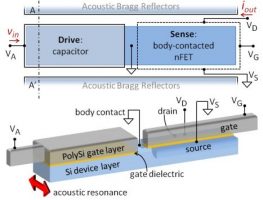
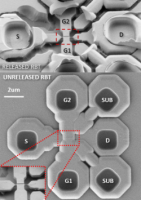
GaN MMIC-MEMS Resonators
As a wide band-gap semiconductor with large breakdown fields and saturation velocities, GaN has been increasingly used in high-power, high-frequency electronics and monolithic microwave integrated circuits (MMICs). At the same time, GaN also has excellent electromechanical properties, including high acoustic velocities and low elastic losses and a strong piezoelectric effect. These qualities make GaN ideal for RF MEMS resonators, and offers a platform for seamless integration of high performance RF MEMS resonators with high power, high frequency electronics. The novelty and high potential of this technology come from the presence of an inherent 2D electron gas (2DEG) present in this structure, which can lead to new acousto-electric capabilities for MEMS resonators. These include features such as the ability to use the 2DEG as an electrode for transduction in the first switchable piezoelectric resonator, as well as an active sensor of the mechanical vibrations, as the channel of a HEMT embedded in an acoustic cavity. These capabilities can lead to truly reconfigurable systems, for wide bandwidth wireless communications.
Leveraging the unique piezoelectric semiconductor properties of GaN and the AlGaN/GaN heterostructure, we realize high-performance piezoelectric GaN MEMS resonators, integrated in standard GaN MMIC process with only two modifications to the standard flow. Within this platform, we are able to study the transduction capabilities of the epitaxial structure, and we demonstrate ground-breaking performance in terms of mechanical quality factor of the resonance, achieving the highest f.Q products measured in GaN to date as enabled by fabrication in a Au-free process. Additionally, we have demonstrated the first solid-state, switchable piezoelectric resonator, using the conductive 2D electron has as an electrode for transduction. We have also shown devices with record-breaking signal-to-noise ratio, using active transistor sensing of mechanical vibrations. These MEMS resonators have been implemented in monolithic oscillators and filters.
Examples
- GaN Lamb mode resonators
- GaN Resonant Body Transistors
- Switchable piezoelectric transduction
- Monolithic oscillators and filters
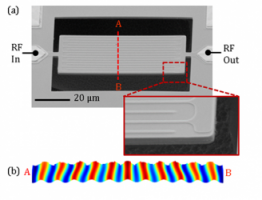

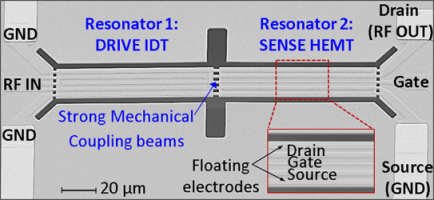
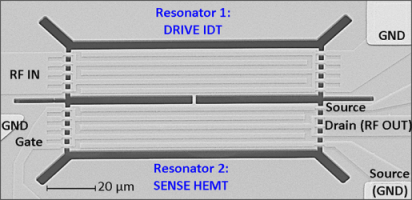
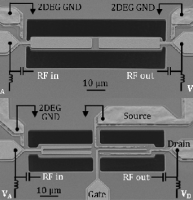
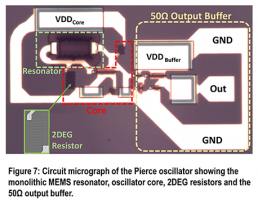
Acoustic Confinement and Guiding
We study and design acoustic confinement and waveguiding structures including Phononic Crystals (PnCs) and Acoustic Bragg Reflectors (ABRs) for high Q resonators, spurious mode suppression, frequency and size scaling, as well as for filtering and active acoustoelectric transmission lines. The lab has focused on lithographically defined structures to achieve acoustic control over multiple frequencies on a single chip. Notably, using PnC waveguides, we have recently demonstrated unreleased CMOS-MEMS resonators with Q>3000 at 3 GHz, enabling a path toward low phase noise timing references embedded on chip in CMOS.
Acoustic waveguiding leveraging Phononic Crystals and Bragg Reflectors can also be used for non-resonant signal processing, including but not limited to spectral sensing, correlation, and isolation. Our group is working actively on new methods of acoustic index guiding to manipulate elastic waves for such applications.
Examples
- Phononic crystals
- Acoustic Bragg reflectors
- Deep trench resonators
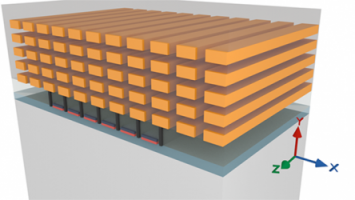
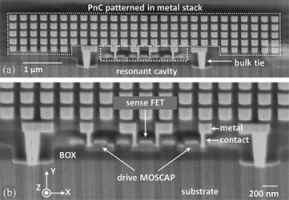
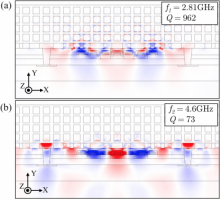
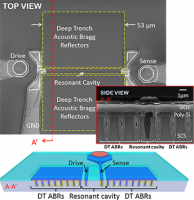
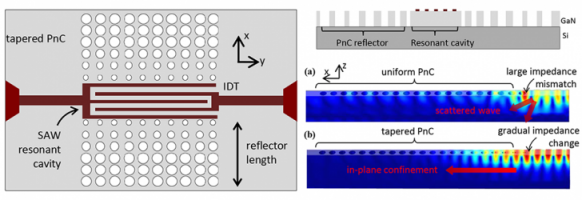
Applications
Neural-inspired computing has great promise for solving problems that require iterative, serial calculations such as image or video processing. These systems perform computations by leveraging behavioral characteristics of a complex interconnected system to obtain a solution when the system reaches a lowest energy state. Through the DARPA UPSIDE program, we are investigating an approach to neural computing by implementing networks of coupled microelectromechanical systems (MEMS) oscillators.
The Acoustoelectric (AE) effect is a result of the interaction between free charge carriers and the electrical deformation potential produced by a propagating elastic wave in the piezoelectric. This two-way interaction results in an exchange of energy between the free carriers and elastic wave, which amounts to controlled, nonreciprocal amplification or attenuation of each. In addition, velocity tuning and phase delay can be achieved. We are investigating this effect both fundamentally in optimized semiconductor-piezoelectric stacks, as well as in exciting applications including correlators and metamaterials.
Other Research Highlights
- Heterogeneous integration of GaN MEMS, HEMTs, and CMOS
- Liquid metal tunable antennas
- Piezo-thermal feedback in bulk resonators